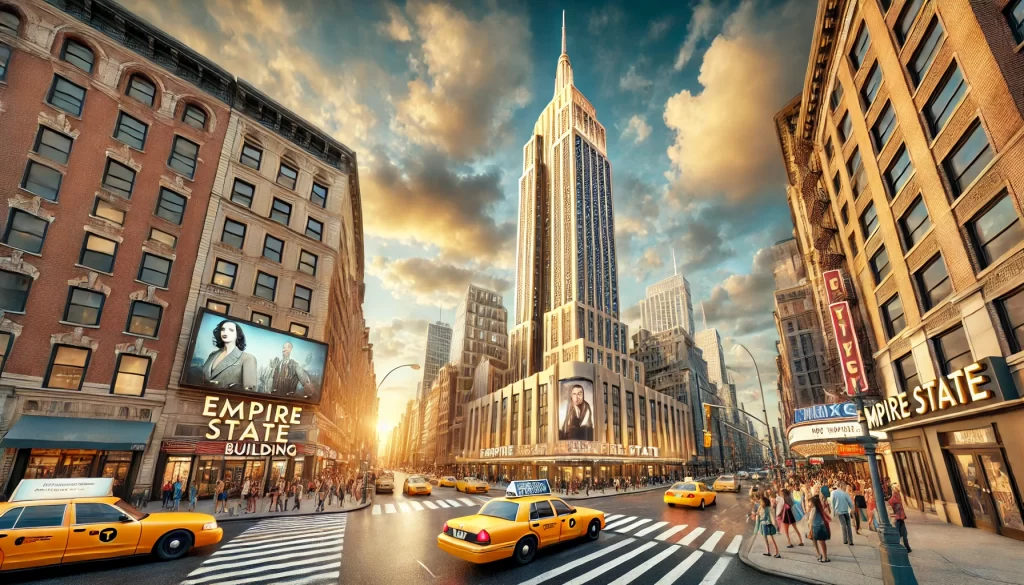Table of Contents
The Empire State Building in New York City is a quintessential example of the sophistication and elegance of Art Deco architecture. Style of Architecture The Empire State Building is more than just a structure; it represents aspiration, creativity, and classic elegance. As one of the most iconic landmarks in the world, this skyscraper has captured the imagination of millions.
The Architectural Style of the Empire State Building stands as a testament to the ingenuity and creativity of the early 20th century. Completed in 1931, this towering structure in the heart of New York City is a perfect example of Art Deco architecture. This style, known for its sleek lines, geometric shapes, and rich detailing, made the Empire State Building a symbol of progress and modernity, showcasing its Art Deco design. But beyond its historical significance, recent updates by Empire State Realty Trust have brought new life to this timeless marvel, keeping it relevant in the ever-evolving architectural landscape.
The History of the Architectural Style of the Empire State Building
The Empire State Building, located on Fifth Avenue in Manhattan, stands as the tallest building in New York and one of the world’s tallest buildings, a true icon of the Art Deco movement. Its architectural style is rooted in the Art Deco design movement, which influenced numerous iconic buildings like the Chrysler Building and the World Trade Center. The building’s clean lines, symmetrical design, and Art Deco features make it a timeless architectural masterpiece.
The Influence of Art Deco
Art Deco design deeply influenced the Empire State Building’s architectural style, widely embraced during the 1920s and 1930s. The building embodies this style’s bold geometric patterns and symmetrical elegance. With its towering spire and intricate detailing, it is an Art Deco skyscraper that has come to represent New York City’s Art Deco heritage. The Empire State Building remains a prime example of Art Deco architecture in the modern world.
The Design Visionaries Behind the Empire State Building
Architect William F. Kennedy was the visionary behind the Empire State Building Lamb and the architectural firm Shreve, Lamb & Harmon. Their design aimed to create the tallest building in the world, an office building that would serve as a symbol of modernity and innovation. Their choice of Art Deco was intentional, as it reflected the cutting-edge design of the time. Shreve, Lamb & Harmon’s work on this architectural landmark marked a milestone in architectural history, with the building’s iconic Art Deco features and symbolic status as an American architectural gem.
The Empire State Building’s Architectural Style’s Timeless Appeal
The Iconic Exterior
The Architectural Style of the Empire State Building The Empire State Building is instantly recognizable by its sleek, stainless-steel spire, originally designed as a mooring mast for airships. It stands as an Art Deco masterpiece in New York City. This feature and the building’s stepped-back design give it a unique silhouette against the New York skyline. The use of Indiana limestone and granite in the construction adds to its timeless appeal, ensuring that it remains as striking today as it was when it was first completed.
The Interiors: A Blend of Elegance and Functionality
Inside, the Empire State Building continues to showcase the Art Deco style through its grand lobby, ornate ceiling murals, and streamlined forms. The building’s interior design was created to exude elegance while being functional for the thousands of visitors and office workers it hosts daily. The careful attention to detail in exterior and interior design has allowed the building to maintain its iconic status for nearly a century.
Architectural Style the Empire State Building: Recent Updates and Exciting Reveals

Modern Enhancements to a Classic Design
While the Architectural Style of the Empire State Building is rooted in the past, recent updates have brought it into the 21st century without compromising its historical integrity. A significant renovation project in 2020 included upgrades to the building’s infrastructure, energy efficiency, and visitor experience, enhancing its status as a premier building in New York City.
Sustainability Meets History
One of the most significant updates is the building’s transformation into an eco-friendly structure. The Empire State Building has undergone extensive retrofitting to reduce its energy consumption by 40%. These changes include installing energy-efficient windows, LED lighting, and a state-of-the-art heating and cooling system. This commitment to sustainability ensures that the building will continue to be a marvel for future generations.
New Visitor Experiences
In addition to the behind-the-scenes upgrades, the Architectural Style of the Empire State Building The Empire State Building is now more accessible to the public through enhanced visitor experiences, including a modern elevator system. The observation decks have been modernized with floor-to-ceiling windows, offering unobstructed views of New York City from the top of the Empire State. The visitor center has also been revamped to include interactive exhibits that detail the building’s history, design, and significance.
The New 102nd Floor Observation Dec
One of the most exciting reveals is the newly renovated 102nd-floor observation deck. Now featuring a glass-enclosed viewing area, visitors can enjoy panoramic city views from one of Manhattan’s highest points. This update enhances the visitor experience and highlights the building’s architectural brilliance.
Also Read: Organism That Makes Its Own Food: Nature’s Incredible Survivors
Maintaining the Empire State Building’s Legacy

A Symbol of Resilience and Innovation
The Architectural Style of the Empire State Building has ensured its place as a symbol of resilience and innovation. Despite being nearly 100 years old, the building inspires architects, designers, and visitors worldwide. Its ability to adapt to modern needs while preserving its historical essence is a testament to the brilliance of its original design.
The Empire State Building in Popular Culture
The Empire State Building has become a cultural icon after appearing in many films, books, and works of art. Its architectural style has influenced other skyscrapers and become a symbol of New York City. From King Kong to Sleepless in Seattle, the building’s presence in popular culture further cements its status as a timeless marvel.
The latest updates and reveals only add to its allure, ensuring that it remains a visitor’s must-see destination and a source of inspiration for future generations. Whether you’re an architecture enthusiast or simply someone who appreciates timeless beauty, the Empire State Building continues to be a marvel in every sense.




